The classical archaeologist Eugen Petersen is known primarily as the long-serving director of DAI Rome. His name is not, however, necessarily associated with the DAI Athens: a good reason to remember him here and recount his time at the Athenian department. The Centraldirektion (Executive Committee [EC]) of the DAI appointed Eugen Petersen First Secretary of the department in 1886. He thus succeeded Ulrich Köhler, when the latter left Athens to assume a professorship in Berlin after eleven highly meritorious years in office. When the official announcement (fig. 1) of the appointment of ‘Professor Dr. Eugen Petersen’ was sent to Athens on October 1, 1886, Köhler had apparently already departed, because the letter was addressed to Habbo G. Lolling, who was temporarily in charge of the department. These and other documents will soon be made available to the public via the project ARCHAthen.
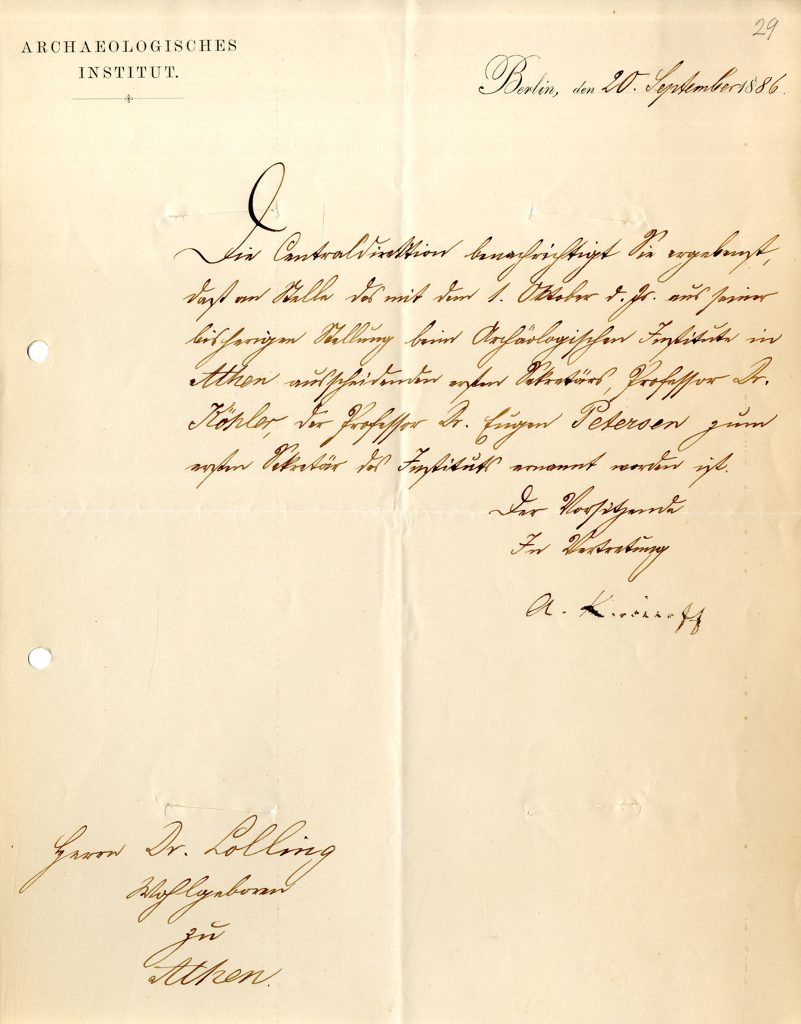
Term in office in Athens
When the Executive Committee decided in favor of Eugen Petersen as its new, now third director of the Athenian department, he was an established, productive scholar with many years of professional experience – among other things, as professor at the universities of Dorpat (Tartu, Estonia) and Prague – with good connections in scholarly circles. In 1873, for example, he had composed a monograph on Greek art titled ‘Die Kunst des Pheidias am Parthenon und zu Olympia’ (‘The art of Pheidias on the Parthenon and at Olympia’). As leading secretary, he spoke at a total of five meetings of the Institute during the Winter of 1886/1887; that is, he gave brief scholarly lectures. For example, on December 9, 1886 – on the occasion of the ‘Winckelmannfeier’ – celebrating the birthday of Johann Joachim Winckelmann – as one of the founders of classical archaeology in Germany – he delivered a talk about Archaic female sculpture on the Acropolis. As usual, several of these talks subsequently appeared in expanded form in the Institute’s own journal, Athenische Mitteilungen. As emerges clearly from them, he dedicated himself predominantly to the art and history of the Acropolis during his time at Athens.
Petersen lived with his wife Ida (née Michaelis) in a faculty apartment (Sporn – Bilis 2018, 22 and fig. 29) in a building rented by the Institute at 31 Akadimias Street. His brother-in-law Adolf Michaelis had lived in a room there not long beforehand in September 1886 and, as he wrote in a letter to his family, anticipated that the couple’s arrival would bring about a significant improvement to his surroundings: “My room is adequate, if small […] You can tell from the furnishings and everything else that only bachelors have ever lived here. That explains a certain lack of comfort […] Ida will find a grateful field for reforms here, likewise in an audit of the furniture.” (von Steuben 2004, 99). The First Secretary and his wife indeed seem to have taken pains to show hospitality: there are accounts of dinners hosted by the Petersens to which they invited younger archaeologists. In winter, however, the apartment nonetheless appears to have been very uncomfortable on account of poor heating.
The experienced excavator Wilhelm Dörpfeld was appointed alongside Petersen as Second Secretary in Athens. In March 1887 – or more precisely, from March 1 to March 13 – Petersen and Dörpfeld undertook a joint excavation in Athens – between the Pnyx and the Theseion. Petersen apparently introduced a diary of finds, which was kept alongside the excavation diary (fig. 2).
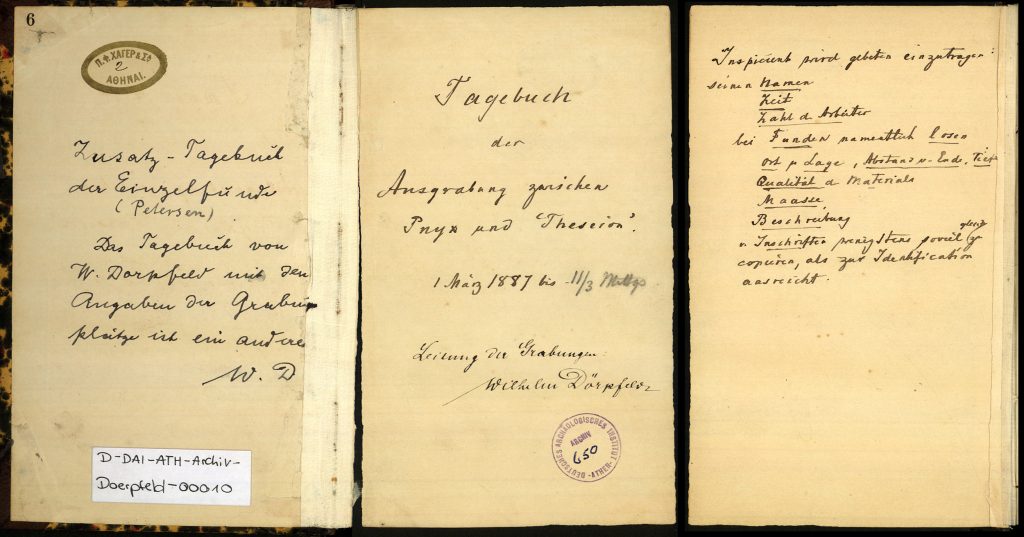
Probably after this excavation, in the spring, the directors and recipients of the travel grant regularly awarded to two to four young archaeologists by the German Archaeological Institute took a trip to Olympia. It was on this trip that the only photograph of Petersen during his term in office in Athens was taken (for the identity of all the people in the photograph, see Brandt 2019, fig. 2 with caption) (fig. 3). As mentioned earlier, Petersen had written an important study of the art of Phidias in Olympia long before the trip, but Wilhelm Dörpfeld was presumably the actual leader of the trip on account of his longstanding familiarity with the site as the technical director of the early excavation in 1875–1881.
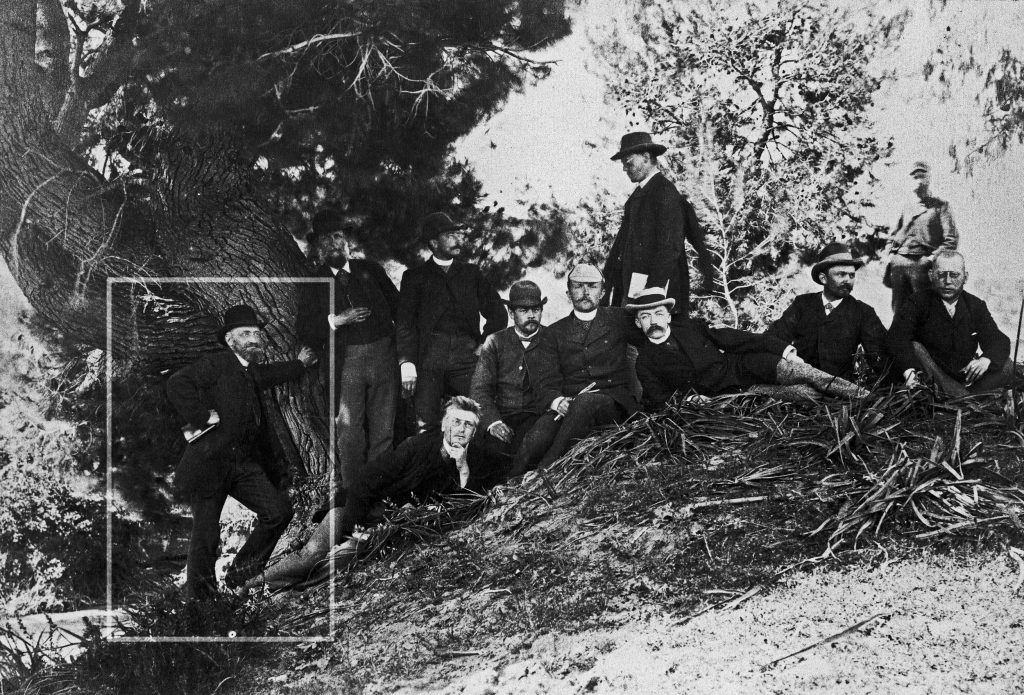
It apparently soon became clear that the personalities of the two men made smooth collaboration impossible. The Executive Committee, thereupon, seized the opportunity to appoint Petersen, after just nine months in office, to the position of First Secretary in Rome, which had unexpectedly become vacant after the death of Wilhelm Henzen (fig. 4). This decision amounted to a promotion and eased tensions in Athens, where Dörpfeld now rose to First Secretary.
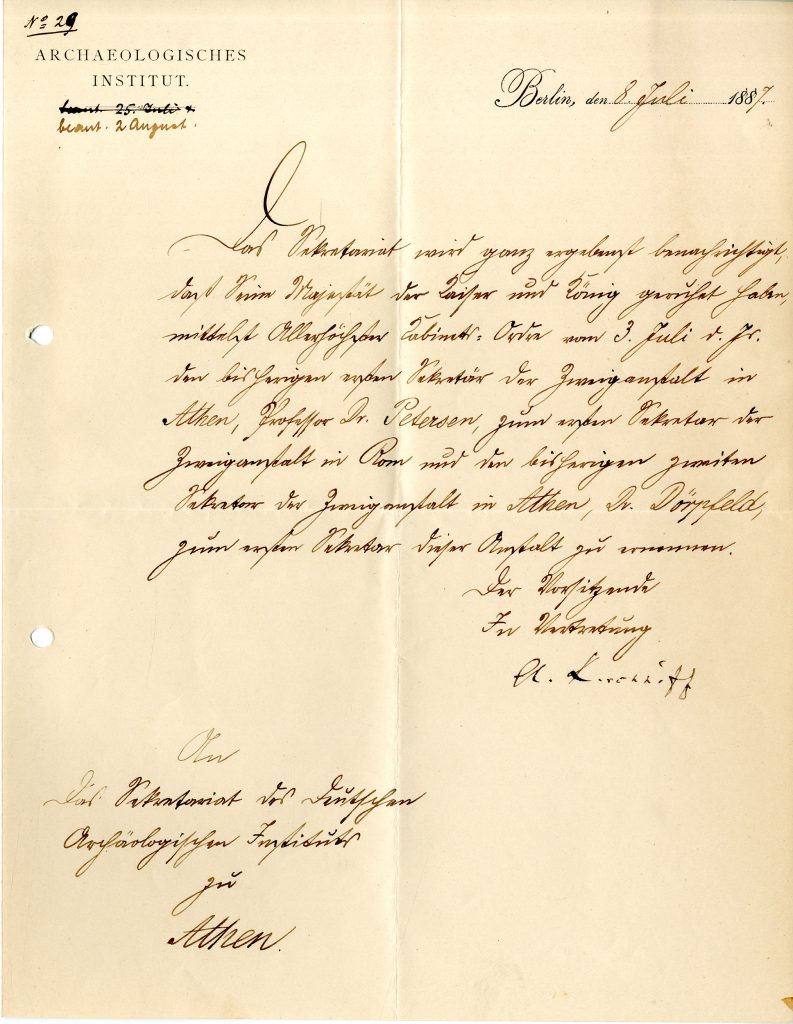
The Lokroi Epizephyrioi Project
Interestingly, the end of Petersen’s career in Athens was not the end of his collaboration with Dörpfeld. When Petersen began an excavation in Lokroi Epizephyrioi with Paolo Orsi, Dörpfeld traveled to Italy with the blessing of the Executive Committee
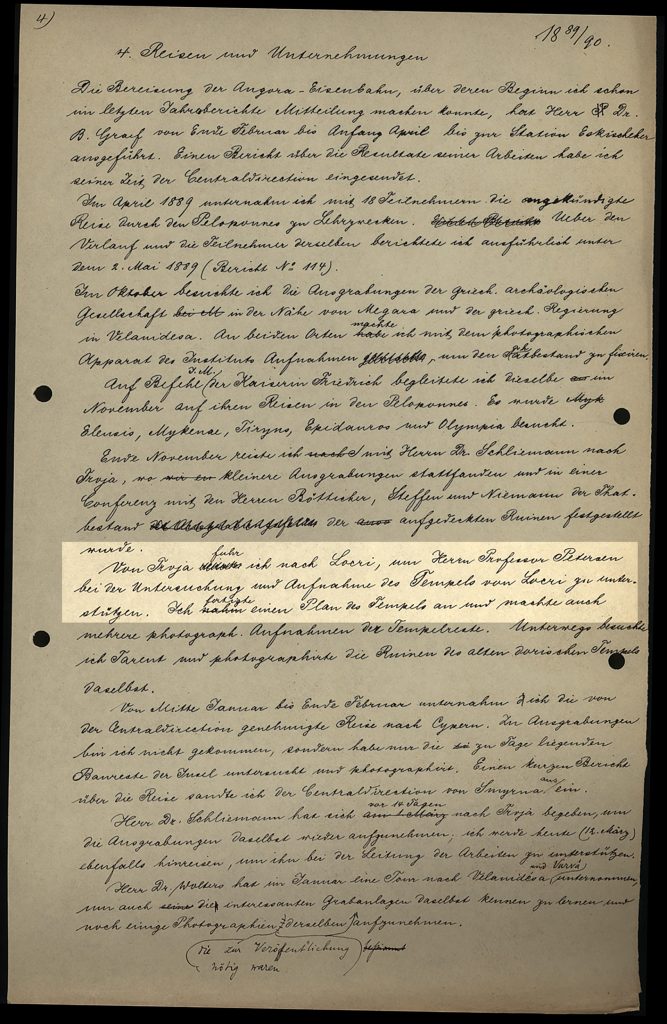
(fig. 5) to draw plans of the temple discovered there and take a series of photographs of finds and contexts. Dörpfeld brought the photographs back with him to Athens, and there the glass negatives remain today as a physical part of the photographic archive in Athens and are available online via the photographic database of the DAI https://arachne.dainst.org/entity/8341. On some of these photographs, the excavator Petersen can be seen, and the Italian archaeologist Paolo Orsi (Malacrino – Musumeci 2018), with whose permission and participation Petersen conducted the excavation.
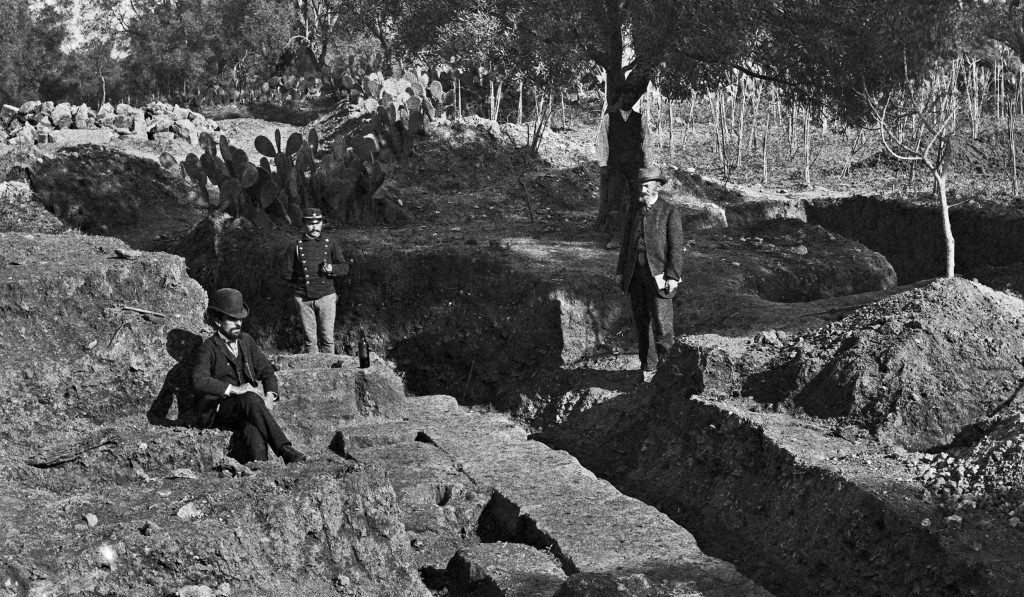
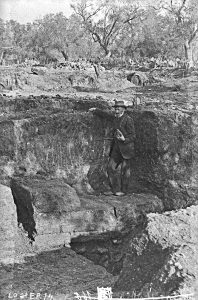
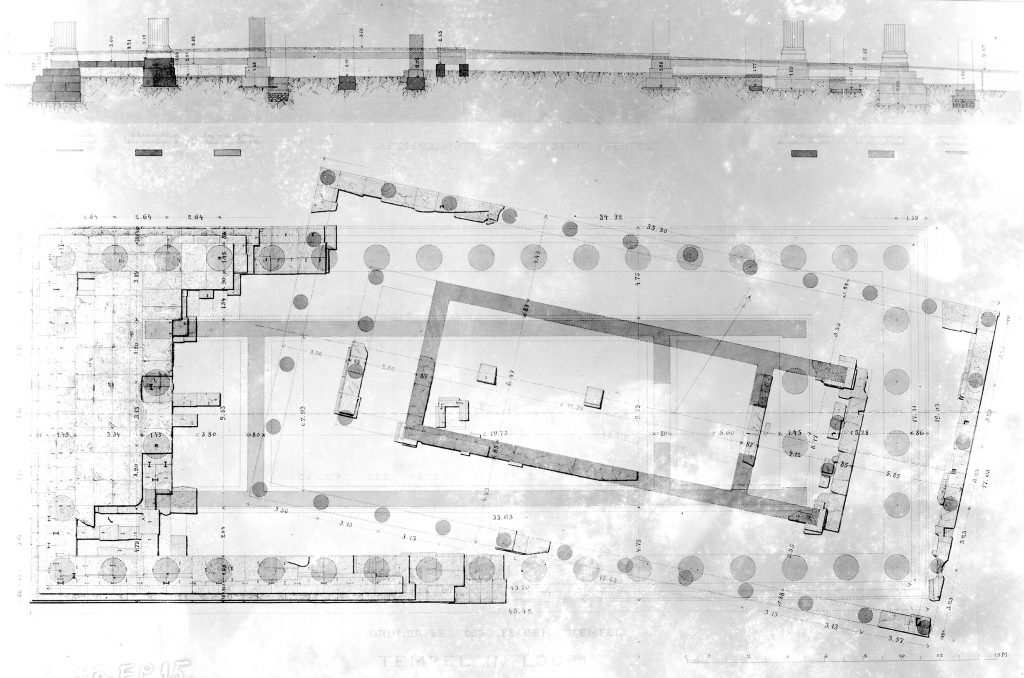
These pictures include two that reproduce Dörpfeld’s drawings of different construction phases of the temple. We can imagine a scenario in which Dörpfeld took his preliminary plans from the field back to Athens, completed them for publication, and subsequently made a photographic copy for the Institute before sending the plans to Petersen. As Petersen later told a colleague in a different context (Wickert 1979, 11) he found Dörpfeld extremely intense – almost frenetic – during their collaboration in Lokroi, but he nonetheless respected him and considered him an honest man.
Retirement and work visit to Athens
Hence it is no surprise that in 1907, two years after Petersen had retired in 1905, during a final visit to Athens he was invited for dinner by Dörpfeld, and, as was the custom, signed Dörpfeld’s guestbook. Now almost seventy years old, Petersen had made the trip to conclude studies that he had begun during his time in Athens. He thus composed the volume ‘Die Burgtempel der Athenaia’ (‘The citadel temples of the Athenaia’), which appeared in 1907, in which he distanced himself from Dörpfeld’s methodology in matter-of-fact terms and developed points of criticism that he had touched on in Athenische Mitteilungen 1887 as an appendix to Dörpfeld’s article about the old temple of Athena. He then published a richly illustrated work on Athens intended for a wider audience in the series ‘Berühmte Kunststätten’ (‘Famous art sites’) in 1908; the Acropolis naturally featured in it prominently. Both volumes are late fruits of Petersen’s time in Athens. He also wrote predominantly on Greek subjects in the following years until his death in 1919.
For Petersen’s bibliography, see https://zenon.dainst.org/ author: Petersen, Eugen Adolf Hermann, 1836–1919
Works cited:
Blanck 1988
H. Blanck, Eugen Petersen (1836–1919), in: R. Lullies – W. Schiering (eds.), Archäologenbildnisse – Porträts und Kurzbiographien von Klassischen Archäologen deutscher Sprache (Mainz 1988) 63 f.
Brandt 2019
K. Brandt, Paul Wolters – in den Blickpunkt gerückt, in: DAI AtheNea 2019, 96–97
Malacrino – Musumeci 2018
C. Malacrino – M. Musumeci (eds.), Paolo Orsi – Alle origini dell’archeologia tra Calabria e Sicilia, MArRC Catalogi 18 (Regio Calabria 2018)
Petersen 1890
E. Petersen, Tempel in Lokri, RM 5, 1890, 11–227
Von Steuben 2004
H. von Steuben (ed.), Adolf Michaelis – Archäologische Reisen in Griechenland 1860 und 1886 (Möhnesee 2004)
L. Wickert 1979
Wickert, Zur Geschichte der Abteilung Athen des Deutschen Archäologischen Instituts von 1879 bis 1929, Beiträge zur Geschichte des Deutschen Archäologischen Instituts, DAIGeschDok 2 (Mainz 1979)
